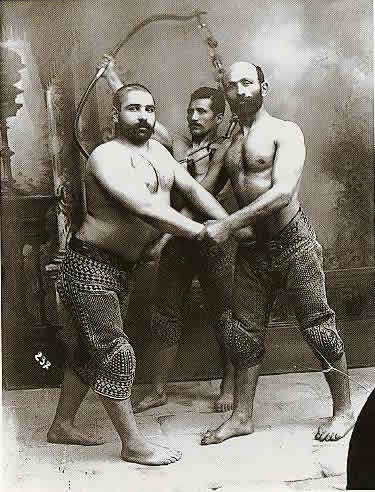|
Sistani Clothing
Sistani clothing is the traditional attire of the people of Sistan. It reflects the region's culture, geography, and centuries of adaptation to the natural environment. Men's clothing Sistani men's clothing includes turbans, hats, shirts, and pants. The turban, known locally as a "langote," is typically white. Men's shirts are long, knee-length, and come in three different styles. Regardless of the shirt's design, the pants are usually plain or pleated. Silk embroidery is often featured in the clothing of the wealthy. In the local Sistani dialect, trousers are called "temu" or "tumon," and the shirt is referred to as "paner." A cracked style of shirt, called "chel treez," features at least 34 slits from the bottom of the sleeve to the hem. Sistani men also wear a vest over their shirt, known as a "jalzgah." Women's clothing Sistani women's clothing is similarly simple and long, resembling men's attire in its loose fit. In addition to their traditional, everyday clothing, ... [...More Info...] [...Related Items...] OR: [Wikipedia] [Google] [Baidu] |
Sistan
Sistān (), also known as Sakastān (, , current name: Zabol) and Sijistan (), is a historical region in south-eastern Iran and extending across the borders of present-day south-western Afghanistan, and south-western Pakistan. Mostly corresponding to the then Achaemenid region of Drangiana and extending southwards of the Helmand River not far off from the city of Alexandria Arachosia, Alexandria in Arachosia. Largely desert, the region is bisected by the Helmand River, which empties into the Hamun Lake, located in Zabol, that forms part of the border between Iran and Afghanistan. Etymology Sistan derives its name from ''Sakastan'' ("the land of the Saka"). The Sakas were a Scythians, Scythian tribe which migrated to the Iranian Plateau and Indus valley between the 2nd century BC and the 1st century, where they carved a kingdom known as the Indo-Scythians, Indo-Scythian Kingdom. In the Bundahishn, a Zoroastrian scripture written in Middle Persian, Pahlavi, the province is called ... [...More Info...] [...Related Items...] OR: [Wikipedia] [Google] [Baidu] |
Sistani (people)
The Sistani Persians () (also known as the Sistanis, Sajestani, and historically referred to Sagzi) are a branch of the Persian people who mainly live in Iranian Sistan in southeastern Iran. They inhabit the northern parts of Sistan and Balouchistan province, where they form minority. In recent decades, many Sistani people have also migrated to other parts of Iran, such as the provinces of Tehran and Golestan in northern Iran. Sistanis speak a dialect of Persian known as Sistani. Etymology Sistanis derive their name from ''Sakastan'' ("the land of the Saka"). The Sakas were a Scythian tribe migrated to the Iranian Plateau. The more ancient Old Persian name of the region – prior to Saka dominance – was ''Zaranka'' or ''Drangiana'' ("waterland"). This older form is also the root of the name Zaranj, capital of the Afghan Nimruz Province. The Drangians were listed among the peoples ruled by the legendary King Ninus before the Achaemenids. Its people were Zoroastrian. Sistan had ... [...More Info...] [...Related Items...] OR: [Wikipedia] [Google] [Baidu] |
Sistani Culture
Sistani may refer to: *Sistan, a historical and geographical region in eastern Iran * Sistani (surname) * Sistani Persians, who mainly inhabit Iran, Afghanistan and Pakistan *Sistani dialect Sistani ( , also known as Sistuni () is a dialect continuum of the Persian language spoken by Sistani Persian people, Sistani people in Iranian Sistan. It is part of the Southwestern Iranian languages, Southwestern Iranian branch of the Indo-Ira ... * Sistani Mahalleh, a village in Iran * Tolombeh-ye Habib Sistani, a village in Iran * Vahdapar va Arbandi Sistani, a village in Iran {{disambiguation, geo ... [...More Info...] [...Related Items...] OR: [Wikipedia] [Google] [Baidu] |
Islamic Clothing
Islamic clothing is clothing that is interpreted as being in accordance with the teachings of Islam. Muslims wear a wide variety of clothing, which is influenced not only by religious considerations, but also by practical, cultural, social, and political factors. In modern times, some Muslims have adopted clothing based on Western traditions, while others wear modern forms of traditional Muslim dress, which over the centuries has typically included long, flowing garments. Besides its practical advantages in the climate of the Middle East, loose-fitting clothing is also generally regarded as conforming to Islamic teachings, which stipulate that body areas which are sexual in nature must be hidden from public view. Traditional dress for Muslim men has typically covered at least the head and the area between the waist and the knees, while women's islamic dress is to conceal the hair and the body from the ankles to the neck. Some Muslim women also cover their face. However, other Mu ... [...More Info...] [...Related Items...] OR: [Wikipedia] [Google] [Baidu] |
Iranian Clothing
Traditional Persian clothing is the historical costume of the Persian people, and of History of Iran#Classical antiquity, ancient Persia (now Iran) before the 1930s Pahlavi dynasty. Historically, the fabric and color of clothing was very important. During the Achaemenid Empire, Achaemenian period (550–330 BC), Persian clothing started to reflect social status and eminence, the climate of the region, and the season. The design philosophy for ancient clothing was a marriage of both function and aesthetics. Images of Persian clothing examples can be seen in ancient art and Persian miniature paintings. Persian miniatures can employ both vivid and muted colors for clothing, although the colors of paint pigment often do not match the colors of dyes. Traditional Persian clothing is seldom worn in urban areas in modern times but has been well preserved in texts and paintings throughout history. History Clothing in Persia is divided into several historical periods, however little is k ... [...More Info...] [...Related Items...] OR: [Wikipedia] [Google] [Baidu] |



